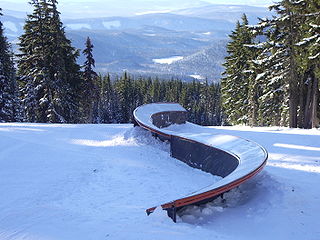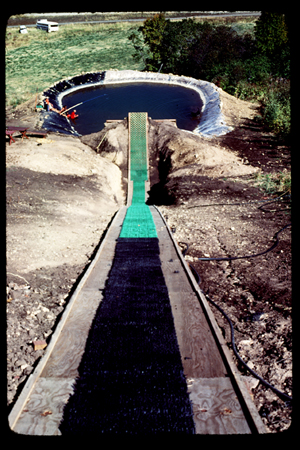
Skiing is the use of skis to glide on snow. Variations of purpose include basic transport, a recreational activity, or a competitive winter sport. Many types of competitive skiing events are recognized by the International Olympic Committee (IOC), and the International Ski Federation (FIS).

Winter sports or winter activities are competitive sports or non-competitive recreational activities which are played on snow or ice. Most are variations of skiing, ice skating and sledding. Traditionally, such games were only played in cold areas during winter, but artificial snow and artificial ice allow more flexibility. Playing areas and fields consist of either snow or ice.

Snowboarding is a recreational and competitive activity that involves descending a snow-coverenoooe while standing on a snowboard that is almost always attached to a rider's feet. It features in the Winter Olympic Games and Winter Paralympic Games.

Ski jumping is a winter sport in which competitors aim to achieve the farthest jump after sliding down on their skis from a specially designed curved ramp. Along with jump length, competitor's aerial style and other factors also affect the final score. Ski jumping was first contested in Norway in the late 19th century, and later spread through Europe and North America in the early 20th century. Along with cross-country skiing, it constitutes the traditional group of Nordic skiing disciplines.
Freestyle skiing is a skiing discipline comprising aerials, moguls, cross, half-pipe, slopestyle and big air as part of the Winter Olympics. It can consist of a skier performing aerial flips and spins and can include skiers sliding rails and boxes on their skis. Known as "hot-dogging" in the early 1970s, it is also commonly referred to as freeskiing, jibbing, as well as many other names, around the world.

The X Games are an annual extreme sports event organized, produced and broadcast by ESPN. Coverage is also shown on ESPN's sister network, ABC. The inaugural X Games were held during the summer of 1995 in Providence and Newport, Rhode Island, United States. Participants compete to win bronze, silver, and gold medals, as well as prize money.

A half-pipe is a structure used in gravity extreme sports such as snowboarding, skateboarding, skiing, freestyle BMX, skating, and scooter riding.

Inline skating is a multi-disciplinary sport and can refer to a number of activities practiced using inline skates. Inline skates typically have two to five polyurethane wheels depending on the style of practice, arranged in a single line by a metal or plastic frame on the underside of a boot. The in-line design allows for greater speed and maneuverability than traditional roller skates. Following this basic design principle, inline skates can be modified to varying degrees to accommodate niche disciplines.

A terrain park or snow park is an outdoor recreation area containing terrain that allows skiers, snowboarders and snowbikers to perform tricks. Terrain parks have their roots in skateparks and many of the features are common to both.

Canada Olympic Park (COP), formerly known as Paskapoo Ski Hill, is a ski hill and multi-purpose training and competition facility located in Calgary, Alberta, Canada, owned and operated by WinSport. It is currently used both for high performance athletic training and for recreational purposes by the general public. Canada Olympic Park was one of the venues for the 1988 Winter Olympics, being the primary venue for ski jumping, bobsleigh, and luge.

Australia first competed in the Winter Olympic Games in 1936 in Garmisch-Partenkirchen, and has participated in every games since, with the exception of the 1948 Games in St. Moritz.

The U.S. Ski Team, operated under the auspices of the United States Ski and Snowboard Association (USSA), develops and supports men's and women's athletes in the sports of alpine skiing, freestyle skiing, cross-country, ski jumping, and Nordic combined. Since 1974 the team and association have been headquartered in Park City, Utah.

Lydia Lassila is an Australian Olympic freestyle skier gold medalist who competed in the 2002 Winter Olympic Games in Salt Lake City, the 2006 Winter Olympic Games in Turin, the 2010 Winter Olympic Games in Vancouver, the 2014 Winter Olympic Games in Sochi, Russia, and the 2018 Winter Olympic Games in Pyeongchang, South Korea. She is the 2010 Olympic champion and the 2014 bronze medalist.

Slopestyle is a winter sport in which athletes ski or snowboard down a course including a variety of obstacles including rails, jumps and other terrain park features. Points are scored for amplitude, originality and quality of tricks. The discipline has its roots in action sports like skateboarding and BMX and has very successfully crossed over into the snow sports worlds of skiing and snowboarding. Skiers use Twin-tip skis for their symmetry since they often go large portions of the course backward and for their balanced weight so as to not destabilize spins. Slopestyle tricks fall mainly into four categories: spins, grinds, grabs and flips, and most tricks done in competition are a combination of these.

The following outline is provided as an overview of and topical guide to skiing:

Competitive cross-country skiing encompasses a variety of race formats and course lengths. Rules of cross-country skiing are sanctioned by the International Ski Federation and by various national organizations. International competitions include the FIS Nordic World Ski Championships, the FIS Cross-Country World Cup, and at the Winter Olympic Games. Such races occur over homologated, groomed courses designed to support classic (in-track) and freestyle events, where the skiers may employ skate skiing. It also encompasses cross-country ski marathon events, sanctioned by the Worldloppet Ski Federation, and cross-country ski orienteering events, sanctioned by the International Orienteering Federation. Related forms of competition are biathlon, where competitors race on cross-country skis and stop to shoot at targets with rifles, and paralympic cross-country skiing that allows athletes with disabilities to compete at cross-country skiing with adaptive equipment.
Matt Chojnacki is a Freestyle Skiing Aerialist on the United States Ski Team from 1995 to 2001 and competed in Freestyle skiing at the 1998 Winter Olympics – Men's aerials. During that period he had six podium finishes, including one win, on the FIS Freestyle Skiing World Cup, and was the 1998 United States National Champion in Aerials.

Lloyd Wallace is a British freestyle skier who competed at the 2018 and 2022 Winter Olympics.
This glossary of skiing and snowboarding terms is a list of definitions of terms and jargon used in skiing, snowboarding, and related winter sports.
















